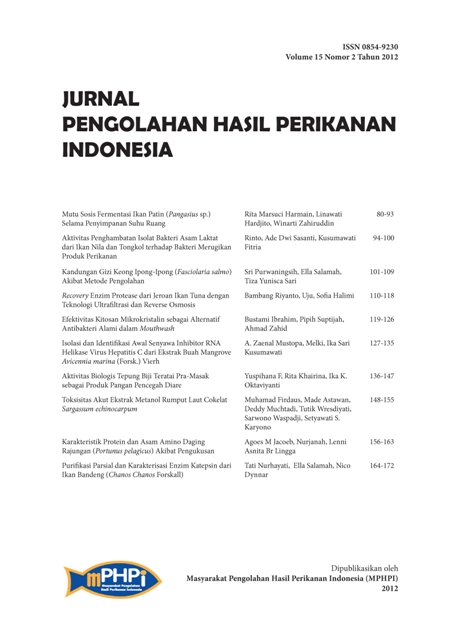KARAKTERISTIK PROTEIN DAN ASAM AMINO DAGING RAJUNGAN (Portunus pelagicus) AKIBAT PENGUKUSAN
Abstract
Crabs (Portunus pelagicus) is one member of the class Crustacea that being a major exported commodity. It is exported mostly in form frozen without head and shell and canned pruduct. Steam process is one important step in crab’s canning industry. This research aimed to study the yield, proximate composition, water-soluble protein, salt-soluble protein, amino acids content and the structure of crabs meat’s tissue analysis in a fresh and after steam process. Fresh crabs has higher yield than the steamed one. Steamed crab’s yield decreased by 14.99%. Proximate composition of fresh and steamed crabs as follows, moisture (wb) 78.47% and 75.43%, ash (db) 7.66% and 6.02%; protein (db) 68.09% and 66.63%; fat (db) 0.84% and 0.75%, charbohydrate (db) 23.41% and 26.62%; water-soluble proteins (db) 40.87% and 25.32%; salt-soluble proteins (db) 58.06% and 30.77%. Crabs meat contained 15 amino acids, 9 essential amino acids and 6 non essential amino acids. The highest essential amino acid composition was arginin by 6.87% in fresh crab and 6.80% in steamed crab, while the highest non essential amino acid composition was glutamate by 10.92% in fresh crab and 9.81% in steamed crab. Fresh crab meat has connective fibers, while the steamed crab meat has disjointed and not compact fibers.
Key words: amino acids, crab (Portunus pelagicus), meat tissue, protein, steaming.
Authors
Authors who publish with this journal agree to the following terms:
- Authors retain copyright and grant the journal right of first publication with the work simultaneously licensed under a Creative Commons Attribution License that allows others to share the work with an acknowledgement of the work's authorship and initial publication in this journal.
- Authors are able to enter into separate, additional contractual arrangements for the non-exclusive distribution of the journal's published version of the work (e.g., post it to an institutional repository or publish it in a book), with an acknowledgement of its initial publication in this journal.





